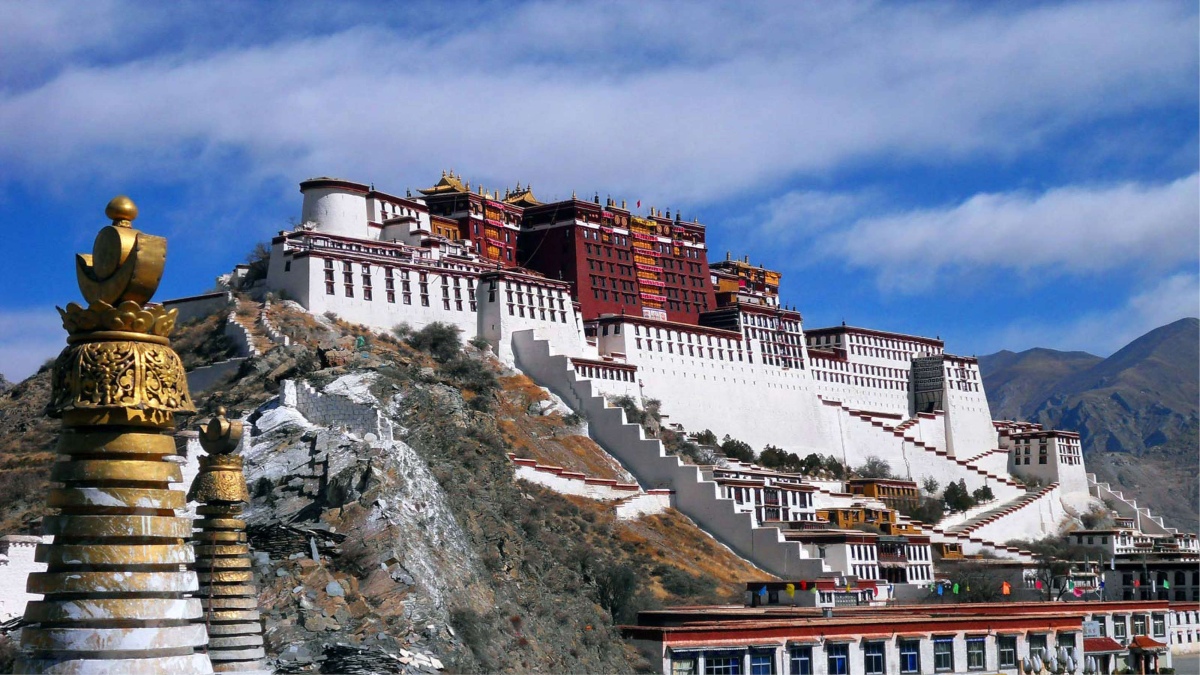When Indian and Tibetan flags were waved at the funeral of Company Leader Nyima Tenzin of Special Frontier Force, there was widespread belief that Tibet would be leveraged. Since then things have moved forward. Tibet is gaining weight in international relations. In the previous articles we had examined the India, Tibet and China triangle through related perspectives. In this concluding article, issues which impact on a ‘Tibet Policy’ to make China look inward are highlighted.
China has embarked on solidification of Tibet. It includes enhanced military infrastructure upgradation of the LAC, control over the Tibetan population and cynicism of Tibetan Buddhism. Ominous. There are credible reports that more than half a million Tibetans are interred in detention centres for skill training and indoctrination under the guise of “poverty alleviation”.
Recently, the US enacted the “Tibetan Policy and Support Act of 2019”. It addresses human rights, religious, cultural, and national identity issues of Tibetans. It stresses on the right of the Tibetan people to choose their religious leaders. A significant point it makes is that Tibetan Buddhism is practised in many countries, including the PRC, Bhutan, Nepal, Mongolia, India, the Russian Federation, and the United States. Hence China cannot nominate a Dalai Lama unilaterally. It talks of dialogue without preconditions between PRC and the Dalai Lama or his reps. It also clarifies that PRC will not be allowed to establish another consulate (in the US) till a US consulate is established in Lhasa.
Meanwhile the next Sikyong (or president) of the Tibetan government-in-exile based in India is to be elected and the primary election was held on 3 January 2021 with the final election slated on 11 April. Tibetans living in exile in India, the United States, Europe, and other countries around the world will cast votes. Allowing this election in India is a tacit message to China. It needs to be taken forward.
China has reacted to both these events. It has warned India against playing the “Tibet Card”. It has reminded India about the 2003 joint declaration in which the Tibet Autonomous Region was recognised as part of the PRC. It also issued a statement denouncing the Tibet Act 2020 of the US. PRC is being very sensitive about Tibet. It is China’s greatest vulnerability. Combine this with Xinjiang and the vulnerability increases. Already Washington Post has come out with an article hyphenating both issues.
If one looks beyond, China has clipped Jack Ma’s wings and is assuming control over financial markets. The high profile arrests/ sentencing of Hong Kong based media mogul Jimmy Lai, real estate tycoon Ren Zhiqiang and citizen journalist Zhang Zhan are indicative of internal turmoil being dealt with a heavy hand. Also, the extent to which China hid the incidence of the Wuhan Virus is now being exposed. The ‘Vaccine’ War it has embarked on is not going well. Most importantly all this is happening in the CCP’s centenary year. If these issues are rolled in with Tibet, along with economic instability and failure in achieving ‘One China Dream’ it will reflect a larger political failure. Overall, things are politically not rosy for China. However, for now we will get back to Tibet.
The US intent to take up issues with China is straight forward. The CTA and the Tibetan diaspora have welcomed the move. Given time, a fair degree of support can be built up within Tibet. However any meaningful headway can occur only if India takes the call. As it is even without Tibet as a lever, Chinese behaviour towards India has mellowed from its initial highhandedness. My guess is that China has realised that it cannot take on the US and India together. It has also probably realised that it will fail if it takes the ‘Teach India a Lesson’ line and also gets badly singed. Hence it is now adopting a conciliatory approach. One thing is clear. If the US, India and CTA act in concert, China will have to change its behaviour. On that there is no doubt.
To reiterate the larger picture China should know that there are red cards if lines are crossed. India must also adopt an overarching ‘Needles in Haystacks’ policy. Build needles in the haystack called Tibet. Roll this haystack with other haystacks- Taiwan, Hong Kong, Xinjiang, Inner Mongolia and Manchuria. Team up with other countries. Build more needles into other haystacks. Ensure these needles move between haystacks. However, we now will stick to Tibet for which India must build political consensus.
The first issue to be pursued is that Tibet was never part of China historically. Hence the relationship between the two should revert to one of suzerainty. This should be the political objective internationally. The basis for this is the Middle Path as enunciated by the Dalai Lama in Strasbourg in 1980: The Tibetan people do not accept the present status of Tibet under the People’s Republic of China. At the same time, they do not seek independence for Tibet, which is a historical fact. Treading a middle path in between these two lies the policy and means to achieve a genuine autonomy for all Tibetans living in the three traditional provinces of Tibet within the framework of the People’s Republic of China…The Government of the People’s Republic of China could remain responsible for Tibet’s foreign policy. The government of Tibet should be founded on a constitution or basic law… a self-governing democratic political entity.
Next. The interpretation of the 2003 Agreement is one-sided—Chinese. It needs a revision through ‘Lawfare’. The 2003 agreement reads: The Indian side agrees to designate Changgu of Sikkim state as the venue for the border trade market; the Chinese side agrees to designate Renqinggang of the Tibet Autonomous Region as the venue for the border trade market. These words establish recognition of Tibet as part of China and Sikkim as part of India. In 2003, it was never put forth by China that the Tibet Autonomous Region extended South of McMahon Line. The common understanding was that Tibet was generally north of the McMahon Line. Chinese claim on Arunachal Pradesh as South Tibet started after 2003. The post-agreement claim on Arunachal Pradesh repudiates the 2003 agreement. All agreements stand violated by China through military aggression in eastern Ladakh. In view of this, India should not recognise Tibet as part of China. Tibet, India recognised in 2003 is disputed. Hence the definition of Tibet should be clarified first. Additionally, based on religious history, the entire area of the Mansarovar Lake is part of Uttarakhand. The entire issue needs renegotiation. Till then treat Tibet as an independent entity.
India needs an intelligence base in Tibet. We need to develop intelligence in depth to cover a wide array of subjects—with or without the US. It is only then that we will have an edifice to progress matters. In any situation, the normal drawback in India has been lack of intelligence. It is a national deficiency which needs to be addressed. Trans LAC human intelligence will play a significant part and needs focus. We must combine media with information and intelligence operations. It is often recognised that our Media gets under the Chinese skin very fast. We need to give our media the free hand to express itself. We also need to project our media into Tibet. It can be done with some innovation.
India is under exploiting Buddhism. All major Buddhist centres lie in the heart of India. We have not leveraged them. One look at Bodh Gaya, Sarnath, Kushinagar, Rajgir, Nalanda, Sanchi and so on tells you the degree of under-leveraging. Further, many important centres of Tibetan Buddhism are in India. These can also be leveraged. Needs a national rethink. If Political Islam can be leveraged, Political Buddhism needs to be propagated. Buddhists in China are not Tibetan alone. They are elsewhere also. There is a wider reach through other countries also. Many hues? Exploit them. Dalai Lama succession is just one aspect.
China is trying to control major Asian rivers emanating from Tibet and exert geopolitical influence over the lower riparian nations. There is adequate scope to take an initiative to form an association of lower riparian nations of Mekong, Salween and Brahmaputra to tackle China politically through international/ multilateral forums. India needs to take the initiative since it is most affected. Our think tanks need to come up with formulations.
The Chinese are worried that India as a whole is going against them. India needs to utilise the wholehearted public support for any action against China and for Tibet more purposefully. It is therefore perplexing as to why India is not leveraging public opinion and democracy. If one notices, China deals with one issue with one country each at a time. Almost a divide and rule philosophy. India is not exploiting the bandwidth of democracy to handle issues multilaterally and the lack of bandwidth in China to do so. People will achieve what governments cannot. Just one placard on Shantipath put ants up Chinese pants. There is plenty of scope in this sphere of activity.
India needs to defend its borders in depth across the LAC. We need to evolve innovative methods in doing so. The areas up to the Eastern and Western highways should be under our lens. We need to organise forces which will deepen the battle field in any future military escalation. India must also develop the capabilities to conduct operations further in depth. It will improve our military depth and stamina. Unless we think differently, China will continue to merrily do whatever it wants to along the LAC and elsewhere.
A major drawback in our approach is lack of knowledge of Tibet and China. In the recent past, I have attended a number of webinars on China. Many of our China experts (and there are only a handful) speak the same language and parrot the same ideas. One gets the feeling that they are speaking from a script. Most of them project a sense of helpless India vis-à-vis a great China whose wrath we have to endure. An informed analysis of China is rare. I wonder if all this is a product of sponsored tours by China! There are credible reports that China is buying and paying to manipulate international media as part of its influence operations. I think there is a necessity for a hard reset. India needs to invest more in knowledge rather than mere information. ‘Knowledge’ is power.
China needs to be shown a red card and served with one if it does not back off. Tibet is a recognised red card. However, it is not a fully credible one. One has to build it into a potent red card along with others. It will not happen overnight. Everything need not be done immediately. It will be a long haul for India. It should be a slow bleed for China.
Lt Gen P.R. Shankar was India’s DG Artillery. He is highly decorated and qualified with vast operational experience. He contributed significantly to the modernisation and indigenisation of Artillery. He is now a Professor in the Aerospace Dept of IIT Madras and is involved in applied research for defence technology. His other articles can be read on www.gunnersshot.com.
A major drawback in our approach is lack of knowledge of Tibet and China. In the recent past, I have attended a number of webinars on China. Many of our China experts (and there are only a handful) speak the same language and parrot the same ideas. One gets the feeling that they are speaking from a script. Most of them project a sense of helpless India vis-à-vis a great China whose wrath we have to endure. An informed analysis of China is rare.













